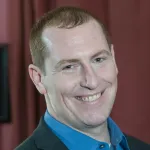Can Love and Pride Advance Public Health? Combating C. diff with Lessons from LGBT Right Movement
Other Categories
I came out to my mom, the late Peggy Lillis, when I was 16. This was 1989, before 9-11, Will & Grace, or Ellen, when mastodons still roamed the earth. Heck, it was even before Speaker Gingrich, his Defense of Marriage Act (DOMA), or the presidency of the man who signed it, Bill Clinton. My mother was not surprised by my pronouncement. Her older brother, Gerard, had come out to her when she was a teenager in the 1960s and she counted several gay men and lesbians among her friends.

My large Irish Catholic family in Brooklyn accepted me as its second openly gay member at the height, or rather the depth, of the AIDS crisis. President Reagan had finally deigned to utter name of the disease amid the demise of his dear friend Rock Hudson. Ignorance and infection panic were still rampant. The surgeon general C. Everett Koop had just conducted the largest-ever mailing on public health to every American household, Understanding AIDS.
For me and millions of LGBT Americans who grew up in the 70s and 80s, last week’s rulings by the Supreme Court demolishing DOMA and defanging California’s Prop 8 reward a quarter century of struggle. The (still unfinished) fight for marriage equality and inclusion in local, state, and federal nondiscrimination laws helped define our identity, in the face of vehement opponents. Judging from the smiles and mood of near total joy I saw pulsing through New York City’s Pride parade last weekend, a sense of triumph was contagious.
Yet this parade for me was a bittersweet ritual. I hadn’t attended since my mother passed away after a sudden but deadly bout with C. diff. in 2010. I missed her terribly when the Supreme Court rulings were announced and her absence felt more acute as we headed into Pride weekend. During her life, my mother also had a complicated relationship with Gay Pride.
In 1994, we lost my uncle Gerard to a heart attack. He was only 47. It was devastating to our family as a whole but for me I lost a mentor and family pioneer. Gerard was a 911 dispatcher and an honorary member of the Gay Officers Action League of New York, with whom he regularly marched in the parade. In 1995, my mother brought his photo for us to hold up along the route. She said, “I want him to be counted in the estimates of the crowd.” It was a day for her to stand for her brother and remember him with me and other gay relatives and friends. Mom attended nearly every Pride Parade from 1995 until her death.
This year, I’ve heard patient safety advocates and allies in a number of other activist circles invoke the gay-rights struggle as a model for how to make progress for their cause. I hear this flattering comparison, or prescription for how to wage a social movement, with a high degree of personal acuity. And skepticism.
When it comes to stopping and preventing the C. diff. epidemic, comparison with advancing LGBT equality is both a spot-on and missed diagnosis, a fit and a misfit.
One important connection involves bearing witness. Like my mother’s own example as an ally for her brother, I feel deeply compelled to tell her story through a foundation that bears her name and combats the disease that claimed her. I am repeatedly inspired by the stories of people moved to fight the C. diff. epidemic by their loved ones.
By speaking out, we honor their lives and, in many cases, their suffering. We give permission to others harmed by healthcare associated infections to value and recognize their own experience, seek recourse for it, and perhaps lessen its impact on others. And we deplete the power of stigma, a key ingredient in rejection by family and friends as well as social isolation and depression, while claiming that power for ourselves.
We also need organizing. One signature area of success for the LGBT movement is building a complex eco-system of organizations for 40 years. These organizations range from the hyper-local to the nationwide. They incubate leaders. They build lists of supporters and raise money. They advocate local policy change and win state ballot measures, counteract stigma in media, and tap popular culture, passion, and their lists to protect gains and propel federal legislation.
There is sometimes friction among these organizations, and they can look duplicative from the outside and even feel precarious or inefficient from the inside. But in all their heterogeneity, they are complementary. The tremendous progress in collaboration among LGBT and allied organizations over the past decade has registered more than equally in legislation, referendum outcomes, and solidarity in public opinion. Still, the movement’s work is far from done. Even in the wake of last week’s victories, America remains without a basic federal law outlawing job and housing bias against LGBT people.
Love, pride, and outspokenness only go so far. The movement to stop and prevent C. diff. needs expert research and scientific innovation as well as bold, strategic, and sustained leadership in both private institutions and government. These are not individual virtues. These ingredients have price tags. They require multi-year private and public investments. They demand systems of inquiry and development and training and management, collaboration, and recalibration through failure and success and to capitalize on breakthroughs.
The fight to stop and prevent C. diff. can draw lessons from the struggle for LGBT equality. But there are limits to that parallel. To paraphrase feminist activist and author Gloria Steinem, any movement aiming for success must build the bridges of empathy necessary to make political inroads. And any effort to advance public health needs clinical know-how and capable leadership besides courage to pave the way to success.



Leave a Reply